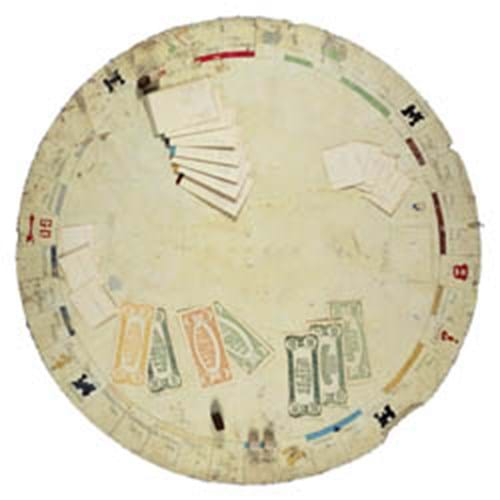
Thought to date from 1933, this was the earliest 'Darrow' set known to survive, the only one of circular shape, and the earliest to include a carbon typescript rules sheet.
One of more than 200 pieces included in the sale, it was estimated at $60,000-80,000 on December 17.
Six early editions of Monopoly, a popular game in the Forbes household, were included in the sale, most of them acquired by Forbes's sons in homage to their father's love of capitalism.
The game of Monopoly has a long and complicated history and an extensive and sometimes contradictory literature. However, there can be no doubt that it became the cultural phenomenon that it did because of an unemployed Philadelphia-area heating engineer by the name of Charles Darrow.
Although Darrow was once supposed to have invented the game of Monopoly - a supposition he encouraged - it is now understood that he was introduced by friends in the Philadelphia area to a home-spun version of the game in early 1933.
Using Atlantic City street names, Monopoly was one of a number of analogous land-trading games that had a modest following in the early decades of the 20th century. They included The Landlord's Game, patented in 1904 by Lizzie J. Magie, a Quaker from Virginia whose belief in Henry George's single tax theory led her to create a game that showed that the landlord always won.
However, Darrow saw that he could reproduce and sell 'his' new game as a way to support his family through the Great Depression, and he set to work producing sets entirely by hand: drawing and colouring the playing-surface, typing deeds and draw-cards on index cards, and cutting houses and hotels from strips of pine.
By this method, Darrow is thought to have produced one or two sets a day before production moved to a nearby printing works where a further 5000 sets were created for local distribution.
He copyrighted Monopoly late in 1933 and the following year, at the second time of asking, sold the game to leading games publisher Parker Brothers in a deal that would make him a millionaire.
Parker sensibly bought the rights to The Landlord's Game for $500 and a yet closer game, Finance, for $10,000 in order to protect their investment, but one of Darrow's great innovations had been the codification of the rules of Monopoly. Certainly future legal cases surrounding the multi-million dollar Monopoly franchise would see it that way.
Charles E. Todd, a hotel manager of Germantown, Philadelphia, who was among the friends who taught the game to Darrow, recalled in a 1976 court testimony that while learning the game Darrow asked him, "Don't you have any rules? I said, no, it is just a fun game for us. He said, will you write me the rules as you remember them and anything you think ought to be changed or improved? I said, oh, yes, be glad to help".
The Forbes collection also included the Monopoly set from which Charles Darrow first learned the game sometime in February or March 1933.
This version of the game made by Charles Todd originated with one Ruth Hoskins, who is now credited with applying New Jersey street names to the game-board. Through a spelling mistake, this very set introduced a famous and enduring error to the US version of Monopoly. Todd copied the place-name of Marven Gardens (a plot of land between Margate and Ventnor Streets in Atlantic City) as Marvin Gardens. Charles Darrow copied Todd, Parker Bros. copied Darrow, and the name has been Marvin Gardens ever since.
Charles E. Todd sold this set to the Monopoly historian Ralph Anspach, who later sold it at Sotheby's New York in December 1992, when it was acquired by Malcolm Forbes. This framed set, in a traditional square format, sold at $21,000.
By Roland Arkell




